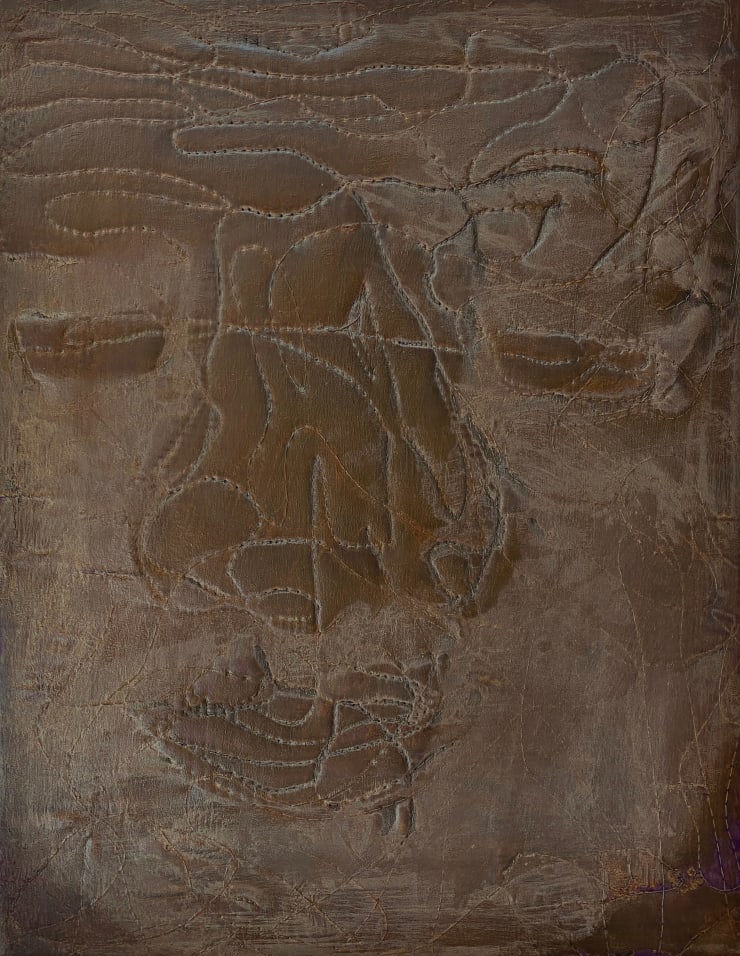Mingi Jung
Mingi Jung is a South Korean artist whose expansive practice explores the visual, political, and emotional resonance of memory, disappearance, and coexistence. Working across textile, sculpture, performance and drawing, Jung transforms the act of stitching into a form of philosophical inquiry—each thread a gesture of care, resistance, or commemoration.
A third-generation descendant of a family steeped in textile, Jung adapts sewing machines, hand-stitching and quilting techniques to develop a language he calls Ifasmoglyph—images not etched into stone like petroglyphs, but sewn onto fabric. These thread-etched works, whether flat or volumetric, bear the marks of touch, repetition, and time. They record not only personal or historical memory, but also what he calls “the massless”—those individuals and stories that history forgets, erases, or leaves bodiless.
His work addresses trauma, collective mourning, and the symbolic burden of representation. Figures encountered in media, myth, protest, or daily life are rendered ghostly through his method—stitched outlines, abstracted forms, spectral textures. His installations often include found wood, dyed muslin, and discarded textiles, embracing imperfection and inviting impermanence.
-
 Mingi JungHarmony – I feel good, 2023Free-motion quilting machine sewing on unbleached muslin, sumi ink and acrylic paint70 x 50 cm
Mingi JungHarmony – I feel good, 2023Free-motion quilting machine sewing on unbleached muslin, sumi ink and acrylic paint70 x 50 cm
27 1/2 x 19 3/4 in -
 Mingi JungHarmony – The face of the earth, 2021Free-motion quilting machine sewing on unbleached muslin, acrylic paint, Korean loess and matte varnish45 x 38 cm
Mingi JungHarmony – The face of the earth, 2021Free-motion quilting machine sewing on unbleached muslin, acrylic paint, Korean loess and matte varnish45 x 38 cm
17 3/4 x 15 in -
 Mingi JungBreath, 2020Hand stitched drawing on unbleached muslin, nylon wool, Korean ochre and matte varnish36 x 20 x 32 cm
Mingi JungBreath, 2020Hand stitched drawing on unbleached muslin, nylon wool, Korean ochre and matte varnish36 x 20 x 32 cm
14 1/8 x 7 7/8 x 12 5/8 in -
 Mingi JungLump – A Dog, 2024Hand-stitched drawing on linen with cotton filling, gesso and acrylic paint29 x 20 x 18 cm
Mingi JungLump – A Dog, 2024Hand-stitched drawing on linen with cotton filling, gesso and acrylic paint29 x 20 x 18 cm
11 3/8 x 7 7/8 x 7 1/8 in -
 Mingi JungBoa Constrictor Swallowed a Chair, 2023machine and hand stitched drawing on unbleached cotton with cotton filling53 x 29 x 223 cm
Mingi JungBoa Constrictor Swallowed a Chair, 2023machine and hand stitched drawing on unbleached cotton with cotton filling53 x 29 x 223 cm
20 7/8 x 11 3/8 x 87 3/4 in -
 Mingi JungSoaring Hidden Dragon, 2023Machine and hand stitched drawing on cotton-blend fabric with cotton filling, plywood panel and wheels35 x 31 x 61 cm
Mingi JungSoaring Hidden Dragon, 2023Machine and hand stitched drawing on cotton-blend fabric with cotton filling, plywood panel and wheels35 x 31 x 61 cm
13 3/4 x 12 1/4 x 24 in -
 Mingi JungListening to gain heart, 2023Machine and hand stitched drawing on linen with cotton filling, acrylic and sumi ink paint110 x 50 x 86 cm
Mingi JungListening to gain heart, 2023Machine and hand stitched drawing on linen with cotton filling, acrylic and sumi ink paint110 x 50 x 86 cm
43 1/4 x 19 3/4 x 33 7/8 in -
 Mingi JungMouse sitting on rice jar, 2023Machine and hand stitched drawing on denim with cotton filling76 x 48 x 52 cm
Mingi JungMouse sitting on rice jar, 2023Machine and hand stitched drawing on denim with cotton filling76 x 48 x 52 cm
29 7/8 x 18 7/8 x 20 1/2 in -
 Mingi JungHistory of tidal flats, 2016Machine and hand stitched drawing on satin, linen with cotton filling152 x 304 x 27 cm
Mingi JungHistory of tidal flats, 2016Machine and hand stitched drawing on satin, linen with cotton filling152 x 304 x 27 cm
59 7/8 x 119 3/4 x 10 5/8 in









